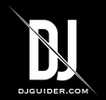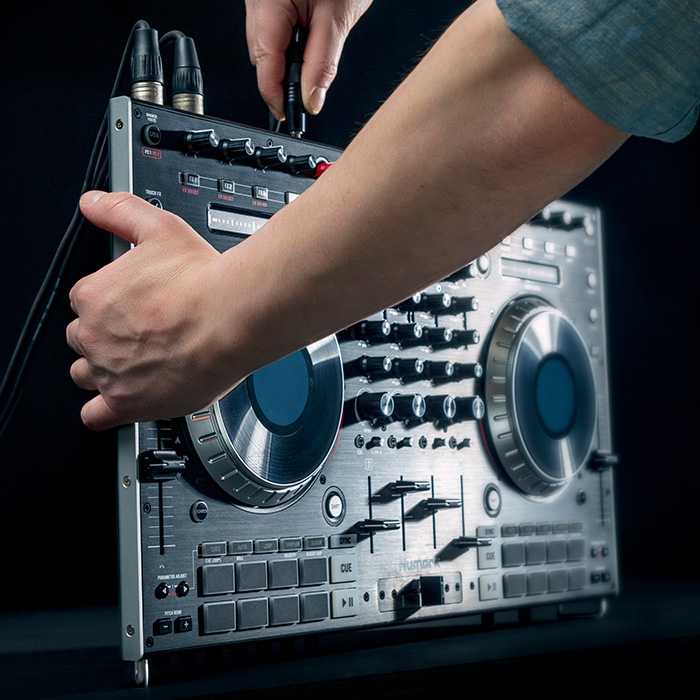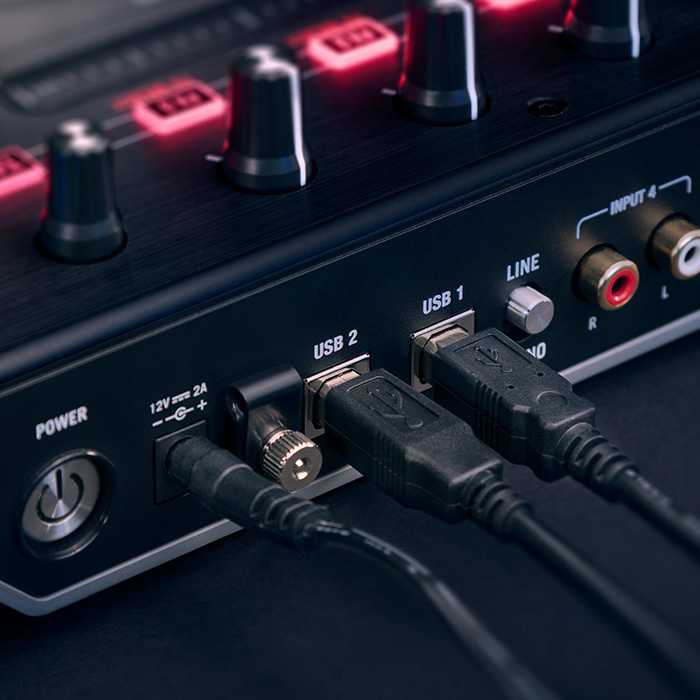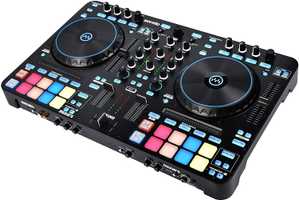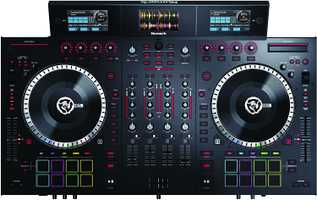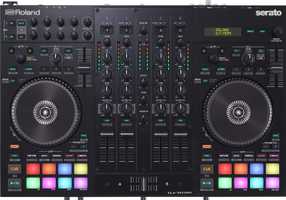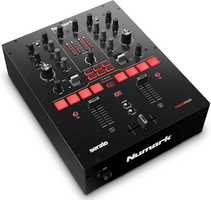Numark NS6II Dj Controller Review
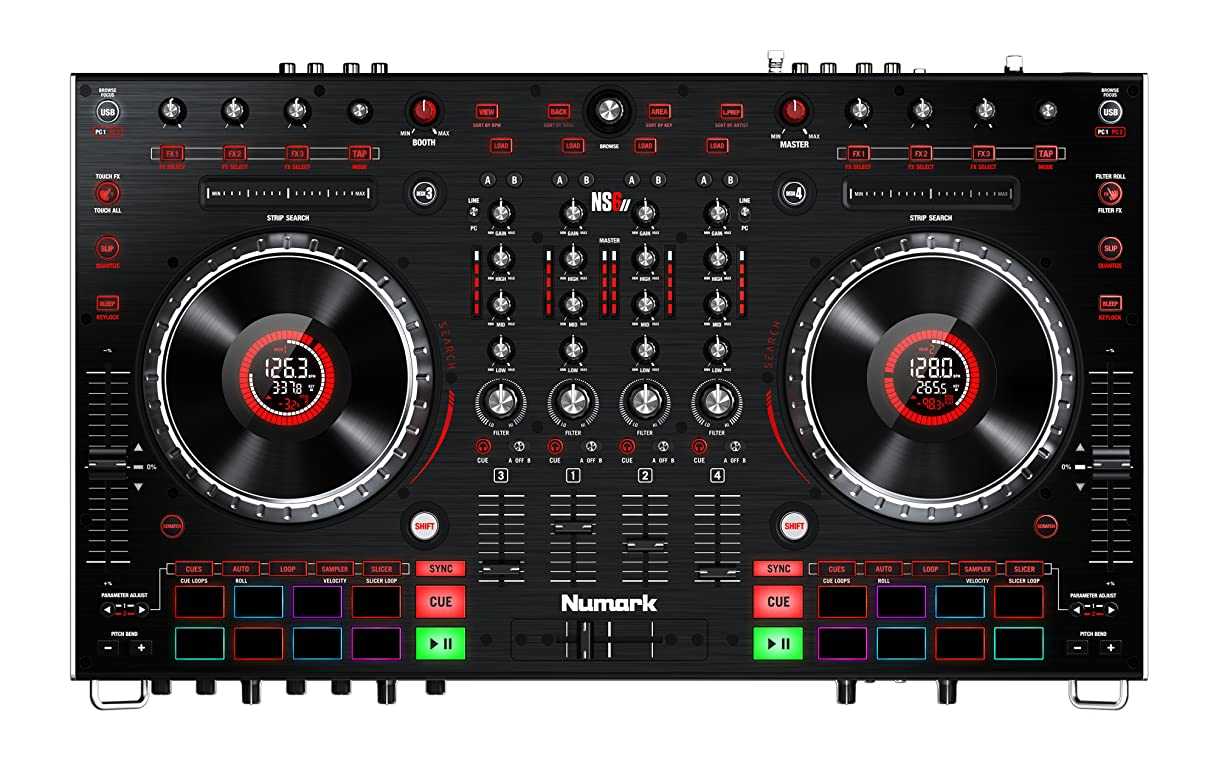
Numark NS6II is almost the perfect controller with Serato DJ Pro and professional features a must-have in a DJ setup, nice construction, and solid design all around. Numark NS6II is an excellent successor. An excellent follow-up to the original and NS6.
- Level: mid-level/professional
- Power: power supply
- Inputs: 2 X MIC, 2 X RCA, 2 X MIC
- Outputs: 1 x RCA master, 1 x XLR master, 1 x RCA Booth, 2 x Headphone
- Supported DJ software: Serato DJ Pro
THINGS WE LIKED
- Dual USB ports for DJ handoffs
- 2-inch color LCD display integrated into each jog wheel
- Digital mixer with (2) phono/line inputs
- Comes with Serato DJ Pro (Full Version)
- Touch-capacitive knobs and 6-inch multi-function jog wheel
THINGS WE DIDN’T LIKE
- Jog wheels take up a big space
- Plasticity feeling faders
I’m here to give you guys the long-awaited review of the new Numark NS6 II Serato D.J controller. So let’s get right into it.
Numark NS6 it’s the follow-up controller to one of my favorite controllers of all time for Serato D.J which was the original NS6 years ago.
Now we have the NS6SII and it has a lot of the features and functions that bring this controller up to date with the new Serato D.J Pro that is now inherent in today’s controller and within the software specifically itself.
FIRST IMPRESSION
So right off the bat, you have a really nice construction, solid design all around you have metal almost everywhere. It’s a little bit of plastic in the design but you have metal underneath all of your knobs.
You have a nice silver finish on the sides. In the bottom, on the front and back panels, you have this plastic-like material for all of your inputs and outputs and all of your controls and adjustments on the front.
DESIGN
Really cool design it looks just like the turntable MTX 1000.
Just like the original NS6 with that silver and black finish which I like very much and it also has the same finish as there the other NS7, NS7 II, and NS7 III and, of course, all the other DJ gear with the same cool Numark finish.
I really like the finish and it still feels really solid, really heavyweight, and great for traveling and mobile deejays.
Good stuff here with the construction. It works with Serrato DJ Pro. You get the full license inside of the box. All you have to do is plug it in and you’re ready to go.
You also have the drivers to download from the Numark website so you can go to the Serrato DJ website and download the latest and greatest Serrato DJ Pro. That way your controller works perfectly.
I/O PORTS
Right off the bat, we’re just going to talk about this controller and everything that it has to offer.
It has the inputs and outputs on the back. First up for inputs you guys have input on channels 3 and 4 which is kind of one of my minor gripes for the unit.
It doesn’t have four standalone different inputs you can only use 3 and 4 so only the outside channels will work for your inputs. You can switch them between line and phone levels meaning you can use your turntables.
It also has a grounding post. It also has two USB ports for the soundcard making it easy for DJ switchovers or for deejays to use this controller two at a time for different tricks. You also have your power cable and you’re on/off switch.
OUTPUTS
For your actual outputs. You have a booth and a master. They’re both RCA and then you have another master balanced output and then you have two microphone inputs as well.
Really good to have two microphone inputs, so that way you can easily have two different people speaking perfectly for your engagements and ceremonies and everything else for the mobile DJ.
FRONT CONTROLS
All the way around to the front of the unit you will see your microphone controls, where your microphone controls have volume knobs and a low and high EQ. You also have your contour control for your cross Fader as well.
Over to the bottom right of the unit you have your headphone section where you have knobs for your volume and also for your fading between CUE, what you hear, and headphones in your master.
Then you have a split cue button as well. You have both of your headphone outputs, so you get both the quarter-inch and the 8-inch variety.
FRONT CUE
Moving right along the face of the unit. The first thing we see is the fader or mixer section, right in the middle. All the way to the bottom you have your cross Fader. Really good smooth crossfader.
It does feel rather plasticky but it has screws on the faceplate itself so that way you can remove this and put it in an inner-fader or mini-fader, whatever fits in there for you. Then you have your line faders which are also really loose and feel really plasticky as well.
I just wish at the professional level these controller manufacturers start putting something like a mini inner-fader in here for line and for the crossfader that really set it over the top but they definitely get the job done. They don’t feel like they’re going to break anytime soon.
Right above the line faders, you have your A-B or OFF switches, that way you can change the side of the channel or you can make them across fader irrelevant by switching that to the off position. You also have your headphone CUE buttons right there next to them as well.
Moving ride along you notice we have a lot of silver and black buttons. These are touch-capacitive knobs. That means when you touch them, you will set them off and throw a Midi signal meaning you can do different things with them such as full EQ when you have your fingers on all of the EQ-s the low mid, and high.
You also have a Gain knob at the top. You also have your filter knobs oversized nice and big at the bottom. Right next to the knobs you also have your LED strip indicator so you can see exactly where you are with your line levels within the mix.
Navigation
Next up at the top you have your brows and navigation functions. You have a big oversized browse knob right at the top. Then you have your load buttons for 1,2,3,4 so that way can load the tracks very easily.
Also at the top, you have your view back area and you also have your L prep so that we can sort all of your different tracks exactly how you need them to see you can easily bring them up.
Below the navigation and browse function you have the A and B buttons so that way you can enact the A side or B side effects on any one of your channels at any given point.
You can’t use the Serrato internal effects on your microphone because your microphone is actually a different line that any of the lines that you see that take up a line. So it’s just a standalone mixer setup with just standalone microphones no effects that you can do from Serrato DJ within.
Master Volume
Next, you also have your nice highlighted and red knobs for your booth and master volume control. That’s really cool to see that they change them there so that way you don’t mistake them for some type of EQ effect or anything else like that. Are obviously read so that way you know that you’re changing a volume master or booth knob.
Touch capacitive knobs
Next up is your traditional affect section where you have touched capacitive knobs. You have FX 1,2 and 3. Then you have another beat or tap encoder as well so that way you have your traditional three EQ setup where you can use all of the effects within Serrato DJ.
Another really cool feature on this unit that we mentioned before is the touch-capacitive knobs. You have your touch affects buttons. When you touch that once turns ON all of your effects.
You can touch the button and they’ll turn the effects on and off as soon as you release it, it’s off once you touch it it’s on. You pressed the button the second time and that brings touch all on, meaning that all of your EQ will be tough to kill. A really cool feature. The same thing that was on the NS7.
There’s also a filter button, so when you press the touch filter button that will allow you to do a roll at the same time when you’re doing your filter. Kind of like a slip-road. Really cool to use.
Then when you press it again you get your filter FX which means it will also filter and enact any one of the effects that you have set up for your FX 1 on either side. Really cool to have these touch effects right here as they do on them on the NS7.
FX controls
Next up below the FX controls you have your Dec 3 and 4 so that way can access your layers for Dec 3 and 4 of these 2 decks. Then you’ll have your strip search where you can easily scroll through your tracks backward and forward so that you can easily get to the place in the track that you wish.
Slipp button
Next up you also have your Slipp button and you also have your bleep button here which will allow you to edit out curse words. Then do a real quick slip so that way anything that you don’t want to hear in the song you can keep having edited out and then when you play it along as if that was never there once you let go of that bleep button.
Pitch sliders
Next to that, you have your pitch sliders they’re all the way to the outside of this controller. They work very nicely. They’re nice and long-throw really deep and they have a nice center light to them. No center click and they just have a nice smooth field of them all around.
Jog wheels
Next up is the all-new jog wheels. These jog wheels are really high resolution. They scratch really nicely and they have a nice loose feel to them. So if you don’t really like the loose feel to them maybe this might not be for you.
Nice and loose nice to scratch with. In the center of the jog wheel, you have that really cool display so you can see your overall track position.
You can also see your needle position so that way you can do jugglers and really cool tricks just easier while you can look at the screens instead of looking at your laptop.
You also get to see the time remaining time elapsed and you get to see your pitch control as well as exactly what percentage you’re at, just by glancing at the jog will face.
One of my minor gripes with the wheels themselves is that the size of the jog will center eliminates a lot of really good scratch space. Sometimes when I was doing my juggles I’d actually be touching the top of the screen instead of an actual scratch space where you have your touch sensitivity.
It’s a minor brat to get used to it over time. At first, when I was doing my joggles I would touch the actual screen but that wouldn’t have any effect on the song playing because you wouldn’t be actually holding onto the touchable surface.
So really good jog will overall really a cool center screen. Wish they would have been just a little bit bigger scratch area, maybe make the controller a little bit bigger next time but, all in all, it’s not going to be a turntablist-style trick type of machine. So it will definitely serve the purpose.
Next up at the bottom you have all of your Serrato deejay Pro performance features for the performance pads. These are really nice pads. They’re the mini Akai MPC pads same as on the Numark NV and the same as the pads found on the Akai smaller mixers and controllers.
Really cool to use here and a feeling just as fine as on any other device that I just mentioned.
We have the cue, the cue loops the Rolls, manuals sampler velocity, and the sampler slicer. And you can often get shifted other things in order to get things like Serrato flip and all of your other functions and tone play and all that stuff is all here and represented well as well.
CONCLUSION
So, in conclusion, Numark NS6II is an excellent successor. An excellent follow-up to the original and NS6.
It really is a flagship-level of DJ controller because it has this really excellent solid build quality perfect for the mobile deejay, perfect for travel, or perfect for anyone who just wants really solid DJ equipment. And they don’t want any plastic or anything that’s just going to break on them any time soon.
It also had that standalone mixer mode and it was Serrato DVS upgrade-ready. Meaning you can attach turntables to this and you can use them with Serrato DJ as long as you have the timecode.
You do have to pay for that upgrade fee but here may be worth it if you want to incorporate turntables into your setup. It also has your dual USB so that way it’s easy for DJ to change over just in case you have this with two different deejays there or two different libraries.
Or it’s easy to use 2 deejays at the same time in case you guys want to do team things or tricks or anything like that.
It also has those touch-sensitive controls which are really cool. We saw that in NS7 and Numark NV really cool touch-sensitive controls for your EQ-s and all of your effects and your rolls.
And it also has a great jog wheel feel and a cool jog wheel center display that shows you all of that tracking information. So you don’t have to look at your Serrato DJ screen as much as you are used to.
It also has those really responsive mini MPC Akai pads for all of your Serrato DJ performance pad features.
DOWNSIDES
The jog wheel center displays are really good and a really nice improvement but they do take up a lot of the surface area for your touch sensitivity.
So you may have to get used to that if you’re used to doing juggles and all of your quick turntable style tricks because you will only be able to use the surface area in order to scratch with.
Also on the downside, it has pretty plasticity feeling faders, crossfader, and the line faders feel pretty cheap. And I just wish all together that they would just start throwing many inner-faders all the way around inside of these new flagship-level controllers.
But the faders do work and the fader crossfader itself is really good to scratch with, so it’s just a minor grind here. But all in all, it’s an excellent DJ controller.
Perfect for surrounded deejays perfect for mobile deejays you need two microphone inputs and that also does need a rock-solid build quality and they use Serato DJ to play.
